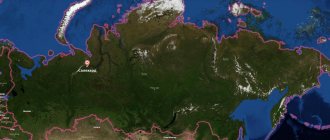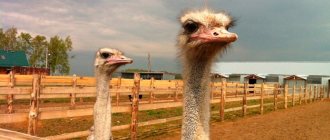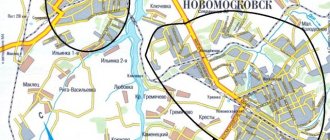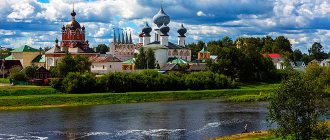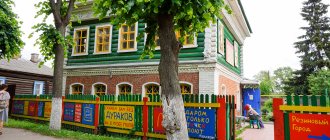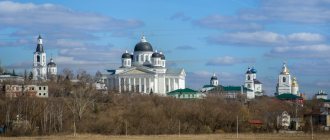Bugulma is located in the east of the European part of Russia and is one of the southeastern large cities in the Republic of Tatarstan. As the satellite map of Bugulma shows, the settlement is separated from Kazan by a distance of 300 km. This is one of the oldest settlements on the territory of the republic, a significant industrial and cultural center. The first mention of the settlement dates back to the mid-18th century.
Bugulma covers an area of 27 km2. The city is home to 82 thousand people, the vast majority of whom are Russians (63%). Other nationalities are represented by Tatars, Chuvash, Mordovians, and Ukrainians. On the map of Bugulma with diagrams you can see that the city does not have a clear division into microdistricts, but the Bugulma residents gave unofficial names to some districts, for example, Sokolskaya Gora, Polyana, Leskhoz.
There are no large freshwater lakes in the city. The main bodies of water that can be seen on the map of Bugulma by region are the Zay, Bugulminka, Kazachya, Sokolka rivers. Rivers and streams run through the entire city and its surroundings. From the north and northeast, Bugulma is surrounded by large forests. In the south it is surrounded by the P-239 highway and a railway line.
Where is the city of Bugulma?
Russia is a vast state, including many republics and regions. Where is Bugulma in Russia? Bugulma is the main administrative center of the Bugulma district in Tatarstan. The Republic of Tatarstan is part of Russia, like other regions and republics, and also has its own traditions that are unusual for the Russian Federation.
Located near Samara, 250 kilometers away.
Central mosque of the city
The largest city mosque is designed, like most Muslim places of worship, in snow-white colors. It is fenced with an openwork fence made of cast iron. This is a modern Muslim building with a characteristic volumetric planning solution. The design of the building displays motifs not only of Eastern Muslim, but also of Bulgarian architecture. Followers of Islam come here to pray. Tourists visit the mosque to admire its beautiful design and become familiar with the ancient culture. Look again how beautiful Bugulma is. A photo of the city and its central mosque is presented below.
Republic of Tatarstan
Tatarstan is a separate country within the Russian Federation with its own customs and holidays. The capital is the beautiful city of Kazan.
Where is Bugulma in Russia? The Republic of Tatarstan is located in the central part of the European side of the Russian Federation, if you look at the map, it is on the slopes of the Bugulma-Shugurovsky plateau, where vegetation predominates.
The area of which is 67836 square kilometers. Bugulma is located in the center of the Bugulminsky - Belebey upland, at the junction of two rivers:
- Volga;
- Kama.
Bugulminsky district
The area of the district is not extensive and amounts to 1408 square kilometers. Located in the southeast of Tatarstan. The region borders Samara and Orenburg, Almetyevsk and Leninogorsk are located nearby.
The area is 67,836 square kilometers, and the highest point is a hill in the state nature reserve called Chatyr-Tau. Bugulma district includes 19 settlements:
- 17 rural;
- two city ones.
Climate and weather
Bugulma district belongs to the southeastern part of the temperate climate zone. A temperate continental climate prevails here.
A characteristic feature of this area is a long autumn and constantly fluctuating winter temperatures.
The average winter temperature is minus 11.5 degrees. The weather in winter is characterized by long frosty months.
The summer weather doesn't last long, but the temperature stays at plus 18.8 degrees. The warm season is delicate and pleasant.
Story
The name of the city comes from the name of the river, which is called Bugulminka. In 1736, the first mention of the settlement “Bugulminskaya” was found in the chronicle, which arose on the site of a small village in the forest near the river, and nearby there was a road well-worn by merchants and merchants.
In 2022, the city turns 284 years old.
In 1773, the main headquarters of the Russian Empire was located here, which was engaged in suppressing the Pugachev rebellion. The territory of the city was transferred from one administrative entity to another, but by decree of Catherine II the city received the status of a county town on December 28, 1781.
Since 1851, Bugulma belonged to the Samara province. At this time, the appearance began to change, and in 1852 city elections were held for board membership.
Just half a century after its official formation, in 1781, the city received the status of a county town.
Bugulminskaya Sloboda was a place of settlement by Russians. It was not serfs who were resettled on the territory of the Bugulminsky district, but young soldiers with their families, and here they were sent into exile under supervision.
Bugulma is a center of trade. Roads from Ufa and Orenburg to the capital of Tatarstan passed through the city. Fairs were held here. The city developed and grew.
National composition in 1897
| Nationalities | % of total residents |
| Russians | 47 |
| Bashkirs | 30 |
| Tatars | 15 |
| Other nationalities | 8 |
In 1911, the Volgo-Bugulminskaya railway line was built through the city.
In 1920, in the Bugulma region, the main type of work was agricultural. Therefore, the city is full of such buildings as:
- mills;
- meat processing plant;
- creamery
Economy and industry of Bugulma
The convenient geographical location of the settlement allowed the city to become one of the largest commercial and industrial settlements at the end of the 18th century. The main routes to Orenburg, Ufa and Kazan passed through Bugulma; traders of fur, fish, and leather goods gathered there. There were 3 large fairs a year, where livestock, horses, food and other goods from remote regions of Russia were sold.
Today Bugulma is an actively developing industrial city. More than 8 thousand citizens work at one of the city-forming enterprises - OJSC Tatneftegeofizika, which has a half-century glorious history. On the detailed map of Bugulma you can see the location of the company.
Also in the city there are Mechanical and Electric Pumping Plants, bakeries, a clothing factory, and a brick factory. Trade is well developed. Local entrepreneurs are working in this area, developing a retail network, and the largest Russian shopping centers have been built.
Yandex maps of Bugulma will help you get acquainted with this interesting city, which has a glorious history; on them you can always quickly find an object of interest, get an idea of the area, roads or railways.
War years
In August 1941, during the Second World War, the 352nd Orsha Red Banner Rifle Division was created in Bugulma. These years were also marked by the construction of a tank column called “Komsomolets of Tatarstan”, which was created thanks to donations from city residents. From May 1944 to May 1945, the strategic bomber PE-8 “Bugulminsky collective farmer” flew.
1948 is a significant year, it was then that the Romashkinskoye oil field was discovered, and in 1950 the Tatneft organization was established; this time is truly considered the second birthday of the city.
"Tatneft" is the exploration of oil deposits and its production in the territory of Tatarstan. Then a transportation center and a scientific center were created to develop the production of “Black Gold”. Thanks to the mining work, the number of city residents increased several times in a short period of time.
In 1974, the general plan of Bugulma was designed under the leadership of Leningrad State University. Between the 1970s and 1990s the city expanded significantly.
Scientists from Moscow on December 12, 1976 translated the word “Bugulma”. As a result, the city could be called “Bykovka”. If you delve into the basics of the Turkic languages, it will become clear that the root of the word “Bug” is equal to the root “bull”. This information was covered by the program “In the World of Words” and most residents knew this feature, since almost everyone listened to the radio.
The world's first sound radio broadcast
In 1672, Italian astronomer Giovanni Cassini discovered another satellite of Saturn - Rhea. It is the second largest satellite of the planet, and in the solar system it is the ninth largest and tenth largest by mass. Previously, Cassini had already discovered four satellites of Saturn and called them “Louis’s stars” in honor of King Louis XIV of France. For many years, Rhea was simply called the fifth satellite of Saturn. And only in 1847, the English scientist John Herschel proposed naming a celestial body in honor of the Titanide Rhea. The satellite itself is covered with a rarefied atmosphere containing diatomic oxygen and carbon dioxide. On its surface, the minimum temperature reaches minus 230 degrees, the maximum - minus 170 degrees.
Photo: wikipedia.org
In 1876, the first constitution of the Ottoman Empire was adopted. It was developed in the spirit of the ideology of Ottomanism by the political circle of the “new Ottomans”. The proclaimed constitution declared personal freedom and equality before the law of all subjects of the Ottoman Empire, regardless of religion, guaranteed the inviolability of private property, a fair taxation system, freedom of the press and much more. However, the modern constitution of the Turkish Republic was ratified in 1921 and was last revised in 2010.
In 1900, Canadian and American inventor Reginald Fessenden conducted the world's first sound radio transmission. In the same year, Fessenden developed a heterodyne reception method, during which sound beats are isolated between high-frequency currents of similar frequencies. However, initially the method did not find its application due to the lack of stable generators of continuous oscillations. The inventor initially worked on Cobb Island in Maryland, and it was here on December 23 that he experimented with a spark transmitter, which resulted in the transmission of a sound signal over a distance of 1 mile. Although the sound quality left much to be desired, Fessenden proved that sound transmission was possible. Later, the inventor began experiments to improve the quality of sound radio transmission. In addition to this achievement, the inventor's legacy includes the first two-way transatlantic radio communication and the first radio broadcast of entertainment and music in 1906.
Photo: wikipedia.org
In 1972, 16 survivors were rescued 73 days after the crash of Air Force Flight 571 in the Andes. The plane crash itself occurred on October 13. The aircraft was flying on the route Montevideo - Mendoza - Santiago. On board the ship were five crew members and 40 passengers, including members of the Old Christians rugby team, as well as their relatives and sponsors. Caught in a cyclone, the plane crashed into a rock and crashed near the extinct volcano Tinguiririka. 12 people died immediately, another five died later from wounds and cold. Then an avalanche killed eight people and several more died from their wounds. The survivors were left with minimal food and no source of heat in the harsh, cold climate. From hunger, the survivors began to eat the frozen bodies of the dead. And only 73 days after the plane crash, two passengers managed to meet a Chilean farmer while searching for rescuers. He gave them first aid and informed the authorities about what had happened. Those rescued were diagnosed with altitude sickness, dehydration, frostbite, scurvy, broken bones and malnutrition.
Diana Zhilenkova
SocietyHistory Tatarstan
Transport accessibility
There is a railway station in Bugulma that connects the city with many villages and towns:
- Ufa;
- Tuymazy;
- Almetyevsk;
- October;
- Leninogorsk.
The area has the Bugulma airport, which is located just 8 kilometers north of the city.
Bugulma consists of several streets in the center, which are adjacent to compact microdistricts. Scheduled public transport for residents includes:
- Shuttle Buses;
- Route taxis.
There is a bus station in the City, from which you can regularly travel to the desired city by bus:
- Samara;
- Orenburg;
- Permian;
- Kumertau;
- Nizhnekamsk;
- Magnitogorsk;
- Sterlitamak;
- Kazan;
- Izhevsk
How to get to Bugulma
The city can be found in the southeastern region of the Republic of Tatarstan.
From Moscow you can fly to Bugulma by plane, which departs from Domodedovo International Airport. The average travel time is 1.5 hours. And from the Kazan station to Bugulma there are electric trains. The average travel time is 24 hours. But by car it will take about 12 hours to get to the Tatar city. The Bugulma city index begins with the following numbers: 4232**. Well, the last information tourists need concerns telephone communications. Bugulma city code + 7–85514. There is no time difference with Moscow.
Sanatoriums of Bugulma
The main attraction is the beautiful virgin nature. This is a real green corner among Tatarstan.
Near the city you can relax not only your soul, but also your body. There are a number of famous, modern sanatoriums and boarding houses.
Sanatorium-preventorium "Lilia"
The place of the sanatorium is imbued with its own energy, thanks to the local landscapes and clean air.
The sanatorium is located in the center of Bugulma and welcomes guests from all over the world.
Treatment profile of the sanatorium:
- problems in the musculoskeletal system;
- problems with the cardiovascular or nervous system;
- digestive organs;
- respiratory system.
- The health resort offers the following healing procedures:
- massotherapy;
- physical training;
- physiotherapy;
- drug treatment;
- galvanic mud and mud applications;
- various types of baths;
- halochamber.
An individual treatment plan is drawn up for each visitor; there are programs for adults and children.
Leisure activities:
- walks through the pine forest;
- operating herbal bar;
- Gym;
- pool;
- entertainment program in the evenings;
- excursions and others.
Sanatorium "Vita"
"Vita" is a modern medical and health institution. It has everything you need to provide quality services in a timely manner. Holidays in Tatarstan are a calm and soulful pastime that helps relieve stress and increase vitality.
The multidisciplinary three-story institution is located in the city of Bugulma near a picturesque park where you can take a walk in your free time from treatment.
The dispensary offers the following services:
- mud bath;
- sauna;
- pool with spring waters.
The entrance to the hospital is equipped with a ramp for small-sized citizens.
Sights of Bugulma
Bugulma not only has a fascinating history, but also many memorials, parks and churches on its territory.
Since the area is located in the center of the Bugulma Upland, here you can find many springs that flow from underground.
Karabash Mountain
On a section of the spur of the Bugulma-Bebelevskaya Upland there is a slope leading to the sources of the Karabash reservoir. Here you can find rare plants and animals in a small area.
Avenue of Heroes
The alley was founded in honor of the 40th anniversary of the celebration of the anniversary of the Victory of the Soviet people in the Second World War in 1975. On the territory of the alley you can find 8 busts of participants in the Great Patriotic War, they are also Heroes of the Soviet Union and natives of the city and region.
Monument to the famous steam locomotive
In August 2011, a monument was erected in the city in honor of the 100th anniversary of the Bugulma railway station. The locomotive can be seen immediately upon arrival in the city at the central railway station. The locomotive carriage was specially repaired and painted. L-3401 is a Soviet mainline steam locomotive that was mass-produced in Bryansk from 1947 to 1955.
Fordson Tractor Monument
On the territory of the Bugulma Agricultural College you can see a monument to a tractor. The monument was erected here for a reason; it was here that training courses for future tractor drivers were organized. The monument of the monument was the original tractor “Fodzon-Putilovets”, which was released from the assembly line in the city of Petrograd in 1926.
Bugulma State Drama Theater named after A. V. Batalov
The cultural center was founded back in 1908. The theater building was originally built as a people's house with a hall for plays. Russian Drama Theater named after. A.V. Batalova is the center of professional theatrical art throughout the Republic. The theater was officially founded in 1935. During the war years, the theater was managed by the actress of the Red Army Theater - N. A. Olshevskaya. Together with her son, she was evacuated to Bugulma. In Soviet times, the theater troupe traveled around Tatarstan, Bashkiria and nearby territories. The theater was in demand and won the hearts of its audience with excellent performances on stage.
Only in 2008 the drama theater received a name in honor of the talented actor A.V. Batalov. This artist began his career in this theater.
Bugulma Museum of Local Lore
When compared with Russian cities, Bugulma is a small, average city. At 88 Herzen Street you can find an amazing place where many archival photographs are stored. Date of foundation: October 1, 1929. The museum is the oldest throughout Tatarstan. The museum clearly shows the entire history of the city, from its foundation to the present day. Among the exhibits you can find:
- newspapers;
- combat leaflets;
- telegrams;
- materials from the KGB archives.
The diversity of nature is also clearly visible in the museum's nature section.
Bugulma Mechanical is a mechanical plant that specializes in the production of equipment:
- oil production;
- processing of petroleum products;
- petrochemical and energy industries.
Thanks to the plant's products, Tatarstan, Russia and many other countries are provided with supplies in this area.
Apartment house of merchant Khakimov
The apartment building is one of the most famous ancient buildings in the city. In 1912, the first cinema was opened here, and the first floor was given over to retail.
Ice Palace "Yubileiny"
The ice palace has an arena for organizing mass skating with the possibility of renting skates. There is also a skate sharpening workshop.
Literary and Memorial Museum of Jaroslav Hasek
In addition to the local history museum in Bugulma, there is another memorable and significant place for the city. The Yaroslav-Hašek Museum on Sovetskaya Street, 67. This is the only museum of its kind.
The museum is located on the territory of the former military commandant's office. From October to December 1918, the Czech writer Hasek performed public service in the role of military commandant in Bugulminsky district.
Among the exhibits you can find:
- important documents;
- Personal Photos;
- collections of stories and essays;
- souvenirs.
The house includes a memorial room and 3 additional rooms.
Memorial of Eternal Glory
The 1960s were marked by the creation of this memorial. The wall of the monument is made of granite and concrete, and behind there is a stele with an unfurled flag. Marble slabs contain 5,560 names of people. In 2000, the memorial was expanded with additional exhibits:
- Tank - T34;
- Armored personnel carrier;
- Dive bomber PE-2.
Monument in honor of the 200th anniversary of the city of Bugulma
It is a sculpture of a man and a woman with their backs turned to a pillar.
Pre-trial detention center No. 3
This building keeps its history and mysteries for residents. Initially, in 1867, Bishop Gerasim of Samara and Stavropol consecrated the temple, giving rise to the formation of a women's community. It later formed into a convent, but in 1931, by decree of the Soviet government, the monastery was closed.
In 1934, pre-trial detention center No. 3 was formed here, since the former cells were suitable for cells.
Museum dedicated to Jaroslav Hasek
The history of the city of Bugulma will not be fully revealed if, after being there, you do not visit the famous museum named after. Yaroslav Hasek. He is known not only in Russia, but throughout Europe. The J. Hasek Museum can be seen only in two countries: Tatarstan and the Czech Republic. The famous building is located between ancient houses. At the entrance to the museum, guests are greeted by the brave soldier Schweik. And although this is only his sculpture, from afar it seems that a real military man is waiting for you. Previously, this house belonged to the merchant Nizheradze. In 1918, Jaroslav Hasek lived and worked within its walls. The writer stayed in the city for only 2 months, but this time was enough for Bugulma to win his heart. The old chairs on which Hasek sat remained in the museum. In one of the rooms you can see a forged chest, an antique desk with heavy drawers, and, of course, hear the chime of the famous French wall clock. The museum welcomes visitors daily from 08.00 to 17.00, except Sundays. The lunch break lasts from 12.00 to 13.00.
Coat of arms of Bugulma
Catherine II assigned the coat of arms to the city. Includes silver fish with blue spots.
In 2007, changes were made to the State Heraldic Register of the Russian Federation and the Republic of Tatarstan. Now the coat of arms contains 3 colors:
- Red symbolizes hard work, strength, courage and beauty.
- Green is a symbol of nature, agriculture and life growth.
- The color blue symbolizes honor, nobility and pure spirituality.
The fish depicted on the coat of arms is a symbol of abundance, and the hill indicates an elevated area in the Bugulma region.



